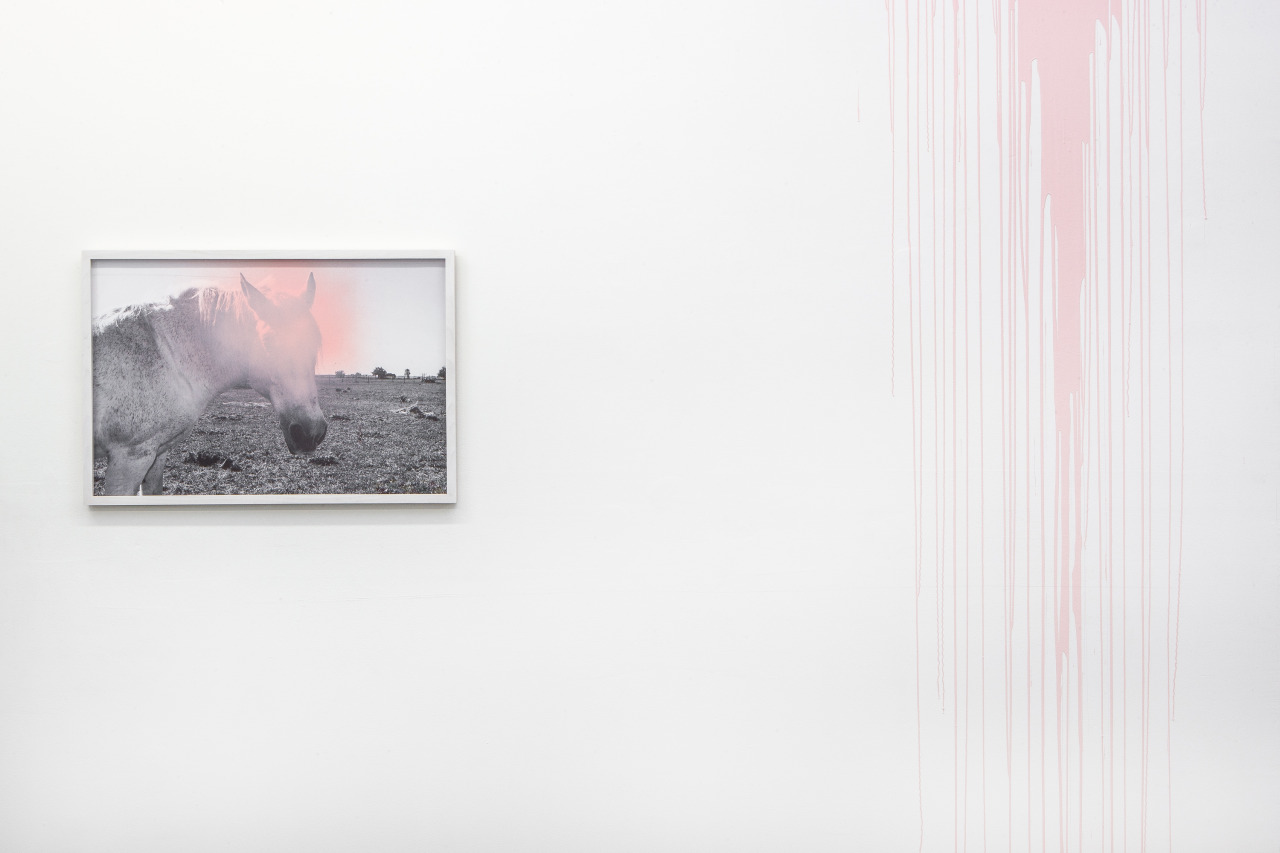
Installation view of I am the horse, Goldfinch, Chicago. Photo credit: Daniel Hojnacki. Left: Iris Bernblum. Pretty baby 3, 2018, spray paint on photo. Right: Iris Bernblum. Pour, 2018, paint on wall, dimensions variable.

Installation view of I am the horse, Goldfinch, Chicago. Photo credit: Daniel Hojnacki. Left: Iris Bernblum. Pretty baby 3, 2018, spray paint on photo. Right: Iris Bernblum. Pour, 2018, paint on wall, dimensions variable.
This is a story of biopower and biosociality…those bitches insisted on the history of companion species, a very mundane and ongoing sort of tale, one full of misunderstandings, achievements, crimes, and renewable hopes. (1) To begin, rest assured that in my epigraph above, Donna Haraway writes ‘bitches’ in reference to dogs designed to service breeding and the interests of humans. However, it occurs to me how language demonstrates its potential to transmigrate across species (a system that is itself, language), and marks out a contentious zone in which femininity is denigrated, and the fact of our animal-ness is charged with a capacity for social abuse and enforced disparities across gender and race. Language is appropriated, and then reappropriated in common parlance, how one might clap back, confirming, ‘Yes, I’m that bitch.’ One wonders, and the wondering is overwhelming, at the intricacies of how language and organism and the institution of gender have been made to conspire in obfuscating life’s interdependencies. Haraway goes on to remind readers that to consider companion species is not only to account for pets, but also the plant- and animal-based foods we consume, cellular genetic modifications, products with less obvious origins among the living (horses, glue, etc.), and techno-hybrid aspects of contemporary life.
The challenge to grasp either the particulars or scope of this paradigm is certainly an (intentional) effect of power. That artists Lise Haller Baggesen and Iris Bernblum succeed at finding starting points to contemplate these entanglements by revisiting the much-maligned genre of ‘horse art’ mostly relegated to the sphere of female adolescence is both novel and moving. In the years I’ve known both artists’ practices, I’ve come to trust that neither are squeamish around topics that are often avoided as much because of how easily they are dismissed as for how problematic they prove to be in their deconstruction. Motherhood, passé disco, unicorns, bucolic landscapes: both artists brave themes that even many other feminists avoid. Their exhibition I Am the Horse now on view at Goldfinch in Garfield Park proves to be écriture feminine (2) équestre par excellence.
If we reside in an oft-unacknowledged natureculture system, Baggesen and Bernblum’s art manifests naturecultureculture, at turns instinctively poetic, strategically conceptual, activist, collaborative, whimsical, and stark. Through paintings (on canvas, on photographs), photographic documentation of playful activations of sculptures (objects that are themselves also on view elsewhere in the space), projected video, drawing, and two audio soundtracks, both artists weave Borromean knots through Lacan’s imaginary and real. (Why would I invoke such an old model of describing experience and consciousness as Lacan, when Baudrillard’s postulations decades ago of a madness of simulations detached from the real seem to be reaching new climaxes of surreal if not unbearable proportions in our present day? I’ll admit, I’m desperate to find means of surviving even thriving, and it’s in my personal bias that I find Lacan useful. It’s certainly a mere mirage of organization, but as with the ‘horse art’ I’m pondering here, it offers me some manageability with which to encounter immense entanglements with which I am otherwise inundated. I am struggling with being in the world, sometimes struggling to even face exhibition openings like this one about which I write. I’m searching for how to be—ethically, aesthetically, politically.)
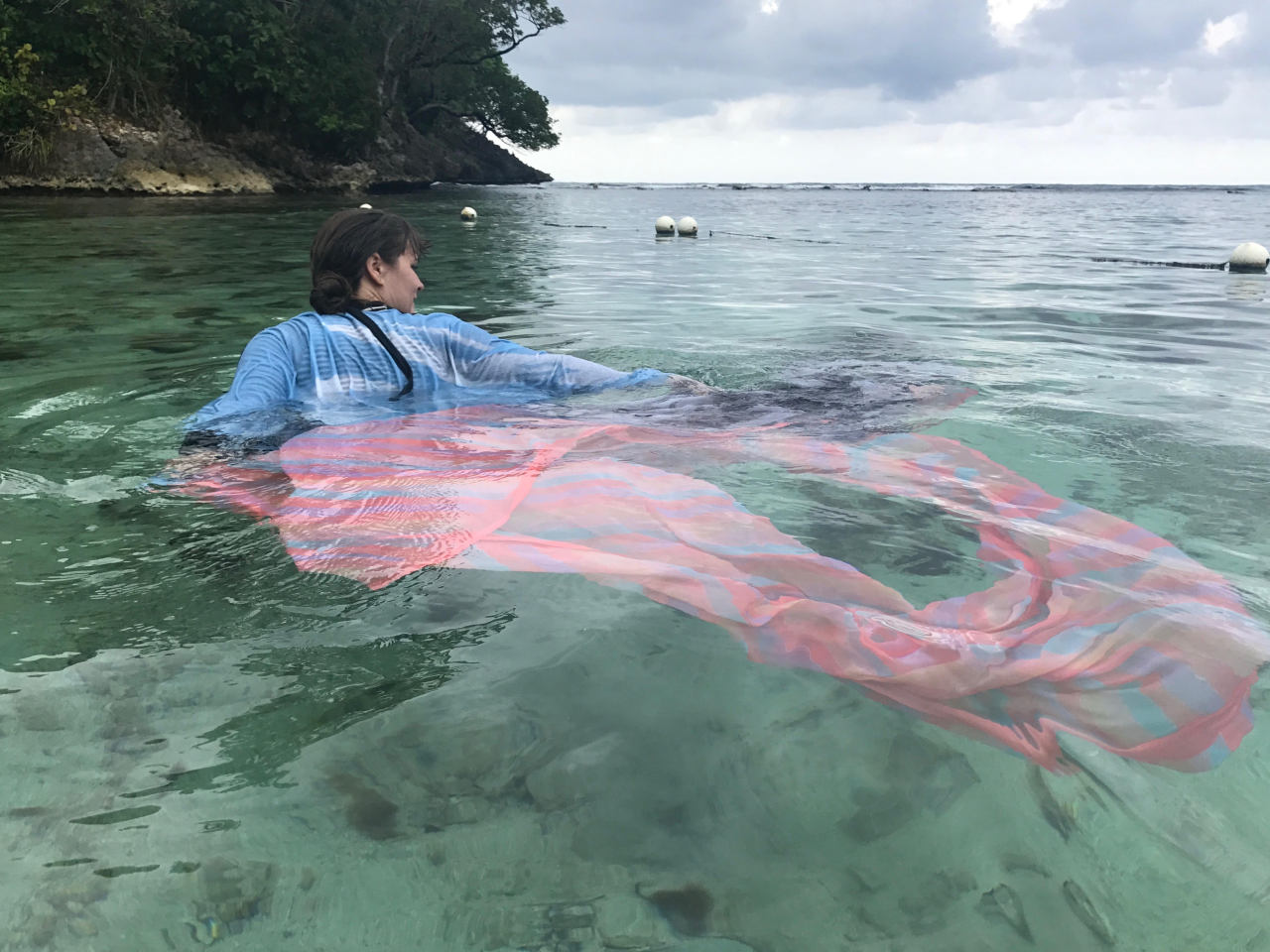
Lise Haller Baggesen. Refusenik on the beach, 2018, Photographic transparency, lightbox. Image courtesy of the artist
It’s in this present state that I feel such affinity for Baggesen’s Refuseniks, a series of costumes that propose hybridity for their wearers (across individuals, across species), by combining structural aspects of jockey shirts and horse blankets, often with multiplied arm holes and equine-shaped hoods. Refusenik (double wearable), 2017, is a melancholic confection draped in the gallery space, possessing all the pluralism of Rei Kawakubo and the lightly floral palette of Dirk Van Saene. In the accompanying photographs, we see these garments not only worn by people and horses alike, but also behaving architectonically, pitched into tents redolent of the Snoezelen-room-inspired immersive installations of Baggesen’s earlier work.
Make. Believe. Dress. Up. Pause to consider these words and phrases while observing Baggesen’s photographs of Refuseniks in the wild. The lightbox Refusenik on the Beach, 2018, shows a figure swimming offshore like an island-bound pony or a mermaid. These scenarios are acted out as conscious performative disengagements from dominant narratives that taxonomize and restrict across gender, age, and species. These works are efforts in conscious play, what psychoanalyst Ernst Kris termed ‘regression in the service of the ego,’ following on the pronouncement of becoming that names the exhibition. I am the horse.
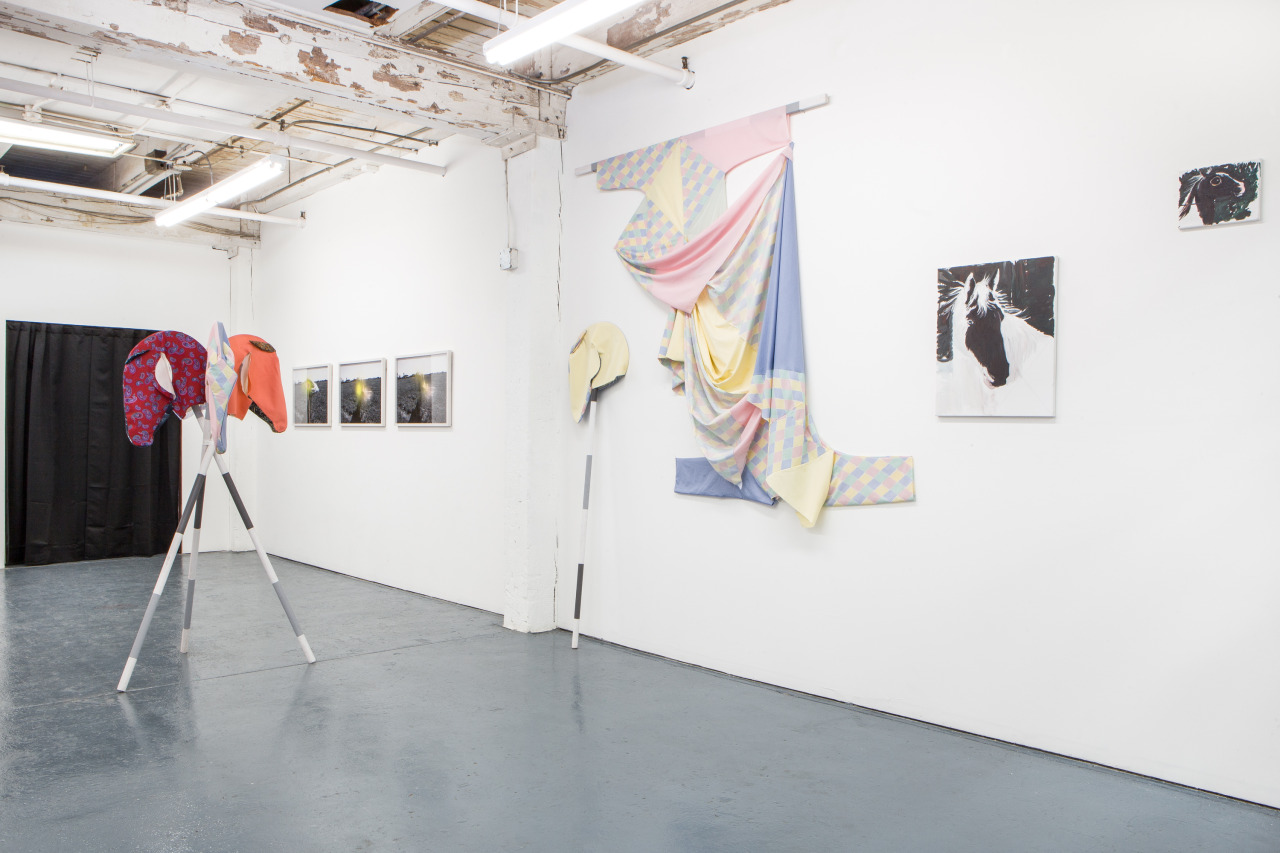
Installation view of I am the horse, Goldfinch, Chicago. Photo credit: Daniel Hojnacki
What’s regrettable and even misguided within the literature that expounds on the bonds between women and horses—and by this, I’m speaking of a body of discourse inclusive not only of psychoanalysis and other modern modes of theory production, but also more expansive treatments of mythology and lore—is that these relationships are nearly always supposed as a substitution for women oriented toward men. The method of using a virgin to attract a unicorn so it may be caught and its horn severed and used for its healing properties is all misdirection: it seems clear to me that this narrative mostly prepares young women to be penetrated by virile conquests. The unfounded rumors of Catherine the Great’s lust for equine copulation follows on her wresting control of the Russian empire from her mentally ill husband. In her case, her strength of will that surpassed the men with whom she was attached and surrounded had to be distorted into bestial proportions in order to maintain a culture organized around male domination. A nebula of dildonic hobby horses, penis envy, the introduction of women riding side-saddle as early as the 14th century as a means of protecting their virginity if not also their decency—horses gallop through all sorts of conceptualizations that would portray women’s sexuality as vulnerable and in need of protection, and also a site of lack, a cavity designed to be filled. It would seem that across the literature that characterizes women’s relationships to horses, men can’t help but recast these attachments as metaphoric pussy grabbing of a most intimate order, territorializing the horse’s body as a prosthetic extension of their own desire and dread and anger (read: misogyny) to control women and their object choices, erotic or otherwise. This is a consuming violence further materialized by the litany of ways that the unchecked, unexamined, privileged marker of ‘men’ is scripted with an entitlement to possess whatever the holder of that sign wishes to possess, to possess and then destroy, and the absolute conviction held within that position that any alternative narratives produced within the culture is metaphoric to them.
It is against this violence and the symbolic order that reifies it that Bernblum and Baggesen act. Upon entering the exhibition, Baggesen’s audio piece, Stallion, 2018, is played on white headphones beneath one of several lightbox photographs in the exhibition that show her piecework Refusenik garments used in tropical landscapes. The sound piece is a sort of audio guide, as if a didactic for a museum collection—a format for working that recurs across Baggesen’s oeuvre and shows how her research operates across writing and studio production. The audio speaks to The Lady and the Unicorn tapestries in Paris’ Musée de Cluny, noting possible symbols for virginity, chastity, and maternity within the textiles’ imagery, with frequent departures into lullaby-like singing and theoretical proposals such as: “’Our selves’ are not located within ‘ourselves’…but are a function of it and vice versa, and personhood is acquired, along with ‘soul,’ gradually and suddenly….” From the start, the logic of this exhibition proceeds counter to any linear theory of development in which a monolithic subject is constituted.
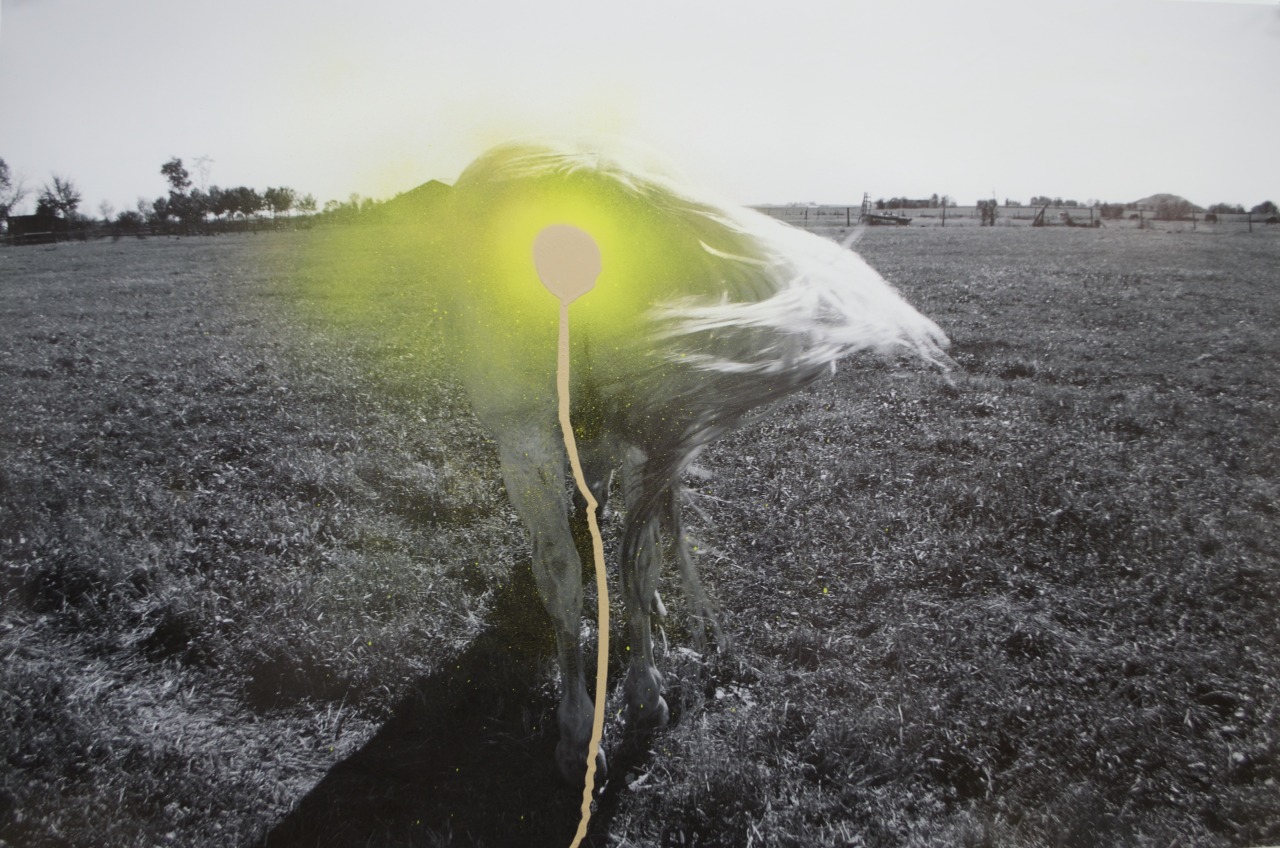
Iris Bernblum. Pretty baby 2, 2018, spray paint on photo. Image courtesy of the artist and Aspect/Ratio Gallery, Chicago
Also from the start, the titular horse in both artists’ projects is haunted by a spectral unicorn. In Bernblum’s Pretty baby 3, 2018, a mottled horse is photographed in black and white. Where a unicorn’s horn might emerge from its head, the artist has sprayed the print with a hazy, glowing pink paint. Is this the body from which her ten-foot-tall unicorn horn-cum-lightning rod Struck, 2016, was removed? While the image conjures fantasies both telepathic and amputating, the action of it as an object—the spray of paint that Bernblum repeats across numerous works—belongs to a nouveau réaliste mode of painting that recalls Niki de Saint Phalle’s Shooting Pictures of the 1960s. The pigment dispersions and drips in Bernblum’s paintings—on photographs, paper, and for Pour, 2018, down the gallery wall itself—are jouissance gestures held at an ambiguous point of rupture, appearing to spill forth, but understood as applied onto the bodies (of horses, of gallery-institution) depicted. This, I have come to feel, is the zone in which Bernblum and her audiences are held—threshold spaces, subtle but provocatively suspenseful, with all the erotic, energetic potential of bodies together pressing into the moment of her artwork. She commands an art herstory that swells from Benglis’ ejaculated spills and Judy Chicago’s spray-painted ‘flesh gates,’ ‘cunts,’ and ‘Great Ladies’ works. Here is one of the linkages between artistic praxis and the horse bodies that roam through the exhibition: these painterly forerunners pushed past pictorial illusionism into the expressive potential of material itself, understood simultaneously through being looked upon (imaginary) and acted with (real). So too, it would seem, do horses. History of science scholar Laurel Braitman notes in her research of how animals are thought about within human culture, “Horses and…unicorns—these are all borderland creatures; gateway animals to other worlds,” she says. “They help us imagine wonderful other ways of being in the world,” of harnessing one’s own power and potential for transformation. (3)
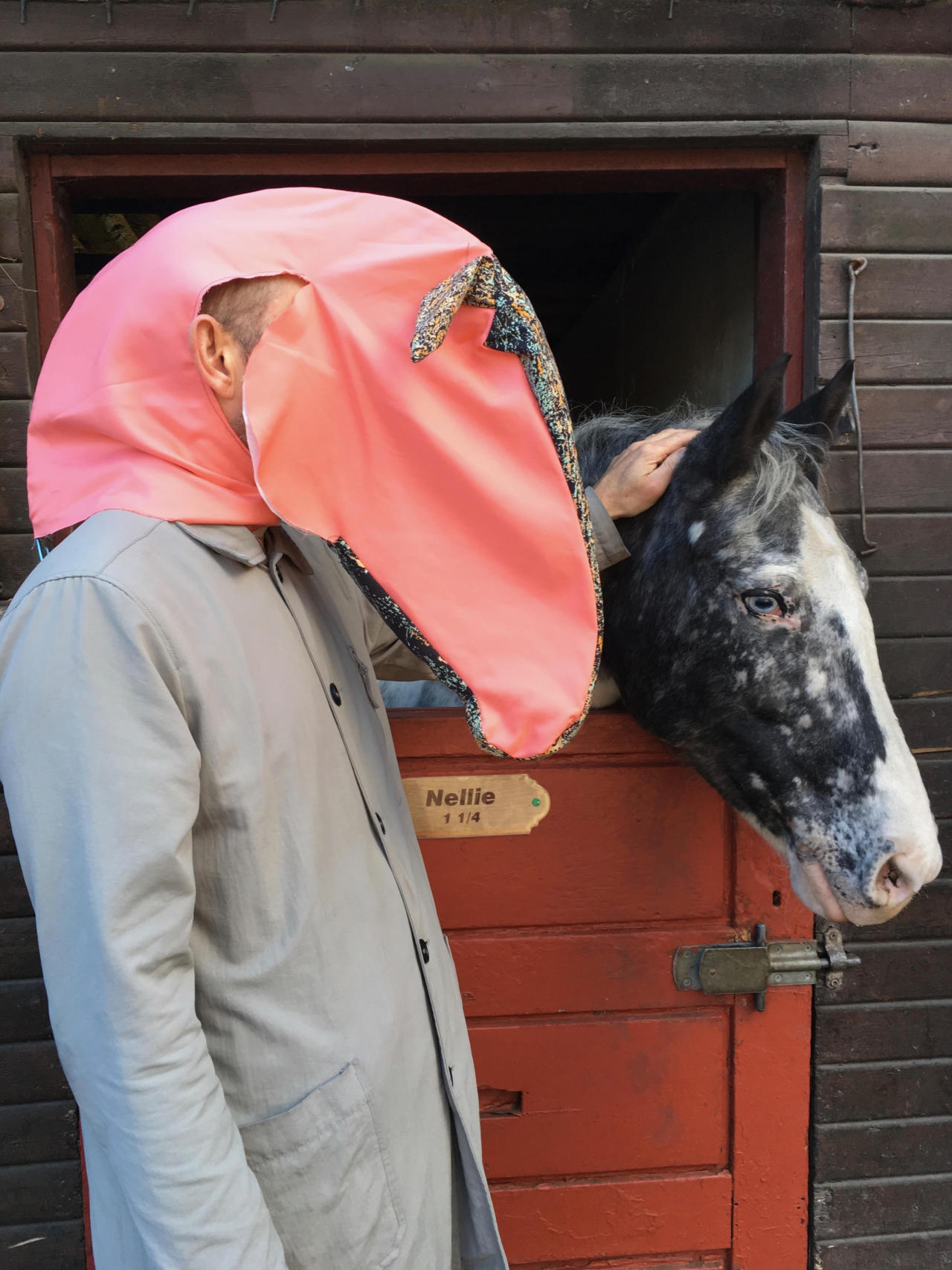
Lise Haller Baggesen. Grown up Refusenik, Copenhagen, October 2017, 2017. Photographic transparency, lightbox. Image courtesy of the artist
The efforts of these two artists sensitize their audiences to the means by which such transformative tools are restricted from use by their situation into early periods of development that are made difficult to access, through stigmas of some sort of arrested adolescence and the assigned roles and responsibilities of adulthood. The assembled artworks, the excursions they document, and the desires they manifest act against capitalist time, the work shift of the laborer, the demands on the time of mothers and working mothers, the imposition of a before and after of sexual awakening. Baggesen’s Grown-up Refusenik, Copenhagen, October 2017, 2017, shows an upright figure standing beside a clear-eyed horse named Nellie. One sees a graying beard along the jawline of the figure, whose head is otherwise masked by a pink horse hood. If not for this fanciful headpiece, this image might recall the other tradition in horse art, the status-symbol equestrian portrait that came to prominence in the 16th–18th centuries of European painting. As it is, one is left to quietly rethink the conceptual divisions upon which our political, economic, and ideological systems depend. What if the hierarchies of speciesism are toppled, and with them, the metaphors that would organize all women’s attachments as preludes or parallels to their being dominated by men? What it the right-wing accelerationism’s tenuous reliance on regulated, linear time might be disrupted in order to gain access to modes of play and being that have been restricted to childhood? What if we breathe, as Bernblum’s two-channel video work breathes, or we make space to catch our breath amidst what feels like a world on fire? What if we explore unbridled, libidinal release that transgresses borderlands? Because, interestingly, Baggesen and Bernblum work into and from facets of écriture féminine that are not essentialist in defining a category of womanhood, but even, as Wittig proposes would “destroy the sexes as a sociological reality if we want to start to exist.” Optimistically, she invites forms of becoming beyond a binary: “To refuse to be a woman, however, does not mean that one has to become a man.” What if, in refusal, we become unicorns?
End Note: I’ve decided that for my series of contributions to Gender Assignment, I want to attach to each essay a selected perfume that I’ve worn through most or all of the drafting of these texts. This can be traced back to my use of perfume in my own art practice, as well as conversations around sensitivity and wellness related to scent that I’ve shared with my host and editor here, Mel Potter, as well as the artists and subjects of this and other forthcoming texts.
For this first essay, I have written within a cloud of Mon Musc a Moi, released in 2015 by A Lab on Fire, designed by Dominique Ropion. This scent opens with quick bursts of bergamot and peach blossom before wrapping a sugary heliotrope-vanilla in wet-fur musks. The perfume house recently renamed the scent Messy SexyTM Just Rolled Out of Bed, and it strikes me that the former name possesses an introspection and reticence that is perhaps in keeping with this exhibition, while its updated moniker casts the scent into a narrative tinged with male-gazey sexual-objecthood that may be more salable, but belies some of the poetry of the scent.
Matt Morris is an artist, writer, and sometimes curator based in Chicago. He analyzes forms of attachment and intimacy through painting, perfume, photography, and institutional critique. He has presented artwork at Adds Donna, The Bike Room, Gallery 400, The Franklin, peregrineprogram, Queer Thoughts, Sector 2337, and Shane Campbell Gallery in Chicago, IL; The Mary + Leigh Block Museum of Art in Evanston, IL; The Elmhurst Art Museum in Elmhurst, IL; Fjord and Vox Populi in Philadelphia, PA; The Contemporary Arts Center, U·turn Art Space, Aisle, and semantics in Cincinnati, OH; Clough-Hanson Gallery and Beige in Memphis, TN; Permanent.Collection in Austin, TX; Cherry + Lucic in Portland, OR; The Poor Farm in Manawa, WI; with additional projects in Reims, France; Greencastle, IN; Lincoln, NE; and Baton Rouge, LA. Morris is a transplant from southern Louisiana who holds a BFA from the Art Academy of Cincinnati, and earned an MFA in Art Theory + Practice from Northwestern University, as well as a Certificate in Gender + Sexuality Studies. In Summer 2017 he earned a Certification in Fairyology from Doreen Virtue, PhD. He is a lecturer at the School of the Art Institute of Chicago and a contributor to Artforum.com, ARTnews, Art Papers, Flash Art, Pelican Bomb, and Sculpture; and his writing appears in numerous exhibition catalogues and artist monographs.
1. Haraway, Donna. The Companion Species Manifesto: Dogs, People, and Significant Otherness. Chicago: Prickly Paradigm Press, 2007. Print, p. 5.
2. <https://en.wikipedia.org/wiki/Écriture_féminine>
3. Quoted in Davia Nelson and Niiki Silva’s “Why Do Girls Love Horses, Unicorns and Dolphins?” All Things Considered. National Public Radio, February 9, 2011. <https://www.npr.org/2011/02/09/133600424/why-do-girls-love-horses-unicorns-and-dolphins>
Goldfinch • 319 N. Albany Ave • Chicago, IL • 60612 • 708-714-0937. Gallery hours are Fri/Sat, 12-4pm, when exhibitions are on view.
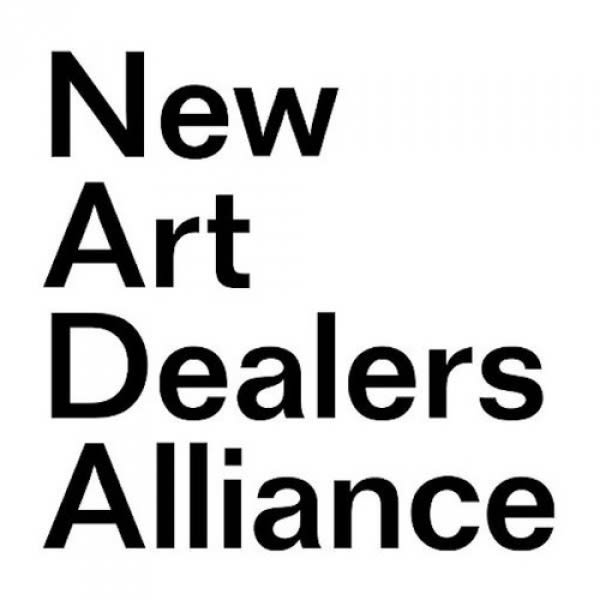
This website uses cookies
This site uses cookies to help make it more useful to you. Please contact us to find out more about our Cookie Policy.
* denotes required fields
We will process the personal data you have supplied in accordance with our privacy policy (available on request). You can unsubscribe or change your preferences at any time by clicking the link in our emails.